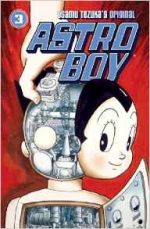
By Osamu Tezuka, translated by Frederik L. Schodt (Dark Horse Manga)
ISBN: 978-1-56971-679-3
From the late 1940s onward until his death in 1989, Osamu Tezuka generated an incomprehensible volume of quality work which transformed the world of manga and how it was perceived. Devoted to Walt Disney’s creations, he performed similar sterling service with Japan’s fledgling animation industry.
The earliest stories were intended for children but right from the start Tezuka’s expansive fairytale stylisations harboured more mature themes and held hidden pleasures for older readers and the legion of fans growing up with his manga masterpieces…
“The God of Comics†was born in Osaka Prefecture on November 3rd 1928, and as a child suffered from a severe illness. The doctor who cured him inspired the lad to study medicine, and although Osamu began drawing professionally whilst at university in 1946, he persevered with college and qualified as a medical practitioner too. Then, as he faced a career crossroads, his mother advised him to do the thing which made him happiest.
He never practiced as a healer but the world was gifted with such masterpieces as Kimba the White Lion, Buddha, Black Jack and so many other graphic narratives.
Working ceaselessly over decades, Tezuka and his creations inevitably matured, but he was always able to speak to the hearts and minds of young and old equally. His creations ranged from the childishly charming to the distinctly disturbing such as The Book of Human Insects.
Tezuka died on February 9th 1989, having produced more than 150,000 pages of timeless comics, created the Japanese anime industry and popularised uniquely Japanese graphic narrative which became a fixture of world culture.
This fourth monochrome digest volume (168 x 109 x 33 mm) continues to present – in non-linear order – early exploits of his signature character, with the emphasis firmly on fantastic fun and family entertainment…
Tetsuwan Atomu (literally “Mighty Atom†but known universally as Astro Boy due to its dissemination around the world as an animated TV cartoon) is a spectacular, riotous, rollicking sci fi action-adventure starring a young boy who also happens to be one of the mightiest robots on Earth.
The series began in 1952 in ShÅnen Kobunsha and ran until March 12th 1968 – although Tezuka often returned to add to the canon in later years. Over that time Astro spawned the aforementioned global TV cartoon boom and starred in comicbook specials, games, toys, collectibles, movies and the undying devotion of generations of ardent fans.
Tezuka frequently drew himself into his tales as a commentator, and in his revisions and introductions often mentioned how he found the restrictions of ShÅnen comics stifling; specifically, having to periodically pause a plot to placate the demands of his audience by providing a blockbusting fight every episode. That’s his prerogative: most of us avid aficionados have no complaints…
Tezuka and his production team were never as wedded to close continuity as fans are. They constantly revised both stories and artwork in later collections, so if you’re a purist you are just plain out of luck. Such tweaking and modifying is the reason this series seems to skip up and down the publishing chronology. The intent is to entertain at all times so stories aren’t treated as gospel and order is not immutable or inviolate.
It’s just comics, guys…
And in case you came in late, here’s a little background to set you up…
In a world where robots are ubiquitous and have won (limited) human rights, brilliant Dr. Tenma lost his son Tobio in a traffic accident. Grief-stricken, the tormented genius used his position as head of Japan’s Ministry of Science to build a replacement. The android his team created was one of the most ground-breaking constructs in history, and for a while Tenma was content.
However, as his mind re-stabilised, Tenma realised the unchanging humanoid was not Tobio and, with cruel clarity, summarily rejected the replacement. Ultimately, the savant removed the insult to his real boy by selling the robot to a shady dealer…
Some time later, independent researcher Professor Ochanomizu was in the audience at a robot circus and realised diminutive performer “Astro†was unlike the other acts – or any artificial being he had ever encountered. Convincing the circus owners to part with the little robot he closely studied the unique creation and realised just what a miracle had come into his hands…
Part of Ochanomizu’s socialization process for Astro included placing him in a family environment and having him attend school just like a real boy. As well as friends and admirers the familiar environment provided another foil and occasional assistant in the bellicose form of Elementary School teacher Higeoyaji (AKA Mr. Mustachio)…
The astonishing exploits resume after ‘A Note to Readers’ – explaining why one thing that hasn’t been altered is the depictions of various racial types in the stories.
‘Robot Land’ originally ran May to September, 1962 in ShÅnen Magazine and sees Dr. Haido fulfil his life’s dream by turning the island of Aragashima into an actualisation of the beloved fairytales and legends he read as a child.
The immense theme park is manned by purpose-built robots and receives an early visit from Ochanomizu and Astro, who are amazed at everything they see. They’re less impressed when the truly terrifying simulacra of Satan and The Dragon go online, but Haido scorns their advice to deactivate the ultimate villains…
Mere months later, an exhausted Swan Princess crashes into Astro’s room. She begins to relate the horrors she has escaped from but is cut short by Satan smashing into the house and demanding her return. After a mighty but inconclusive struggle, the monster plays his trump card and claims the fugitive is Haido’s property and must be surrendered. The doctor, it seems, is as debased as his worst creations…
Undeterred, Astro Boy resolves to help and goes undercover, discovering the sweet land of childish fantasy has been turned into a ghastly gulag run like a dictatorship with helpless robots enslaved by Haido and Satan, who pay for their empire of evil by building advanced weaponry for criminals.
Once he knows the score, all Astro Boy can do is battle on until the armed camp of evil is destroyed, or he is…
‘Ivan the Fool’ (February-March 1959 in ShÅnen Magazine) details how Earth’s first luxury-liner spaceship The Titan is hit by a meteor on its maiden voyage.
As the panicked passengers head for the life-pods, Astro Boy ends up in the same capsule as a disparate and relatively unsavoury cross-section of humanity including a petty bully, a spoiled family, a minor celebrity and a jewel thief…
The crisis is far from over. Lacking sufficient fuel, the pod can’t reach Earth and with tension mounting Astro has to crash the tiny vessel on the Moon. Mystery replaces terror as the survivors discover air, a (relatively) benign environment and evidence of prior civilisation. The desperate situation quickly degenerates into an outrageous holiday experience, but with Astro trying assorted ways to alert Earth to their plight, the mood radically shifts again after a lurking monster is spotted…
When the Mighty Atom finds an old ship he uncovers an incredible story of the first days of Russian space exploration and sorts out a rescue mission, but somebody has noticed a vast field of diamonds and is not ready to leave quite yet. It’s a recipe for death and disaster…
Cultural tradition was acknowledged and updated in ‘A Day to Remember’ (ShÅnen Magazine special expanded summer edition 1960) as the O-Bon Lantern (Day of the Dead) Festival was re-imagined to encompass robot copies of departed loved ones annually returning for a 3-day visit. Sadly, this particular year a recent bereavement leaves no time to construct a facsimile and Astro is asked to play the role of the robot revenant for a family whose little boy has died…
His discomfort at playing substitute ends when Astro discovers Jiro was a genius who built a time machine in his bedroom; something his parents only learn after a gangster bursts in demanding a return on the illicit cash he advanced the kid to build it…
After dispensing with the thug Astro Boy hops into the chronal carriage and follows Jiro’s path, ending up in the turbulent 20th century on a rescue mission that promises plenty of peril before the inevitable happy ending…
The exotically eccentric escapades then conclude with ‘Ghost Manufacturing Machine’ from the 1957 Supplement Edition of ShÅnen Magazine, which begins with scientists testing their latest horrific discoveries made in the service of the most evil man on Earth.
Premier Hitlini is a madman and ambitious dictator without parallel. His chief boffin Professor Pablos is not coming up with the goods he needs to further his schemes and is about to be replaced by Ochanomizu… even though the benevolent technologist doesn’t know it yet…
A frantic warning arrives too late and Ochanomizu is abducted to totalitarian Golgania, but when Astro Boy attempts to rescue his mentor he is prevented by international law which proscribes robots entering another country without human invitation.
Astro fumes in frustration as the Professor is compelled to work on Hitlini’s dream: a device to make duplicates of the dictator so his tyranny will be eternal. However his family eventually convince him to go, promising to handle the legal repercussions…
The toy boy wonder invades the embattled nation and experiences all manner of subtle horror and brutal threats. Autonomous robots and androids are forbidden. The government has lobotomised most mechanicals, turning them into slaves of Hitlini’s war machine, ever-ready to extend his power.
Soon, however, Astro has joined the Robot Resistance and befriended their leader Quantum. The valiant freedom fighter has a secret: he was built by Pablos and has contacts in the very heart of the dictator’s sanctum…
Meanwhile, deep inside the palace the laboratories are buzzing. Reluctant Ochanomizu is making progress, despite interference from Pablos, but neither suspect what the tyrant has planned for them as soon as they succeed.
…And when Quantum is captured, all long-range plans evaporate and Astro decides his only option is a direct assault. However, neither the Mighty Atom nor Ochanomizu realise the situation has also forced the hand of the secret plotter in the dictator’s inner circle and events have rapidly spiralled into murderous anarchy and chaos…
Breathtaking pace, outrageous invention, slapstick comedy, heart-wrenching sentiment and frenetic action are the hallmarks of these captivating comics constructions: perfect examples of Tezuka’s uncanny storytelling gifts which can still deliver a potent punch and instil wide-eyed wonder on a variety of intellectual levels.
Tetsuwan Atom by Osama Tezuka © 2002 by Tezuka Productions. All rights reserved. Astro Boy is a registered trademark of Tezuka Productions Co., Ltd., Tokyo Japan. Unedited translation © 2002 Frederik L. Schodt.










